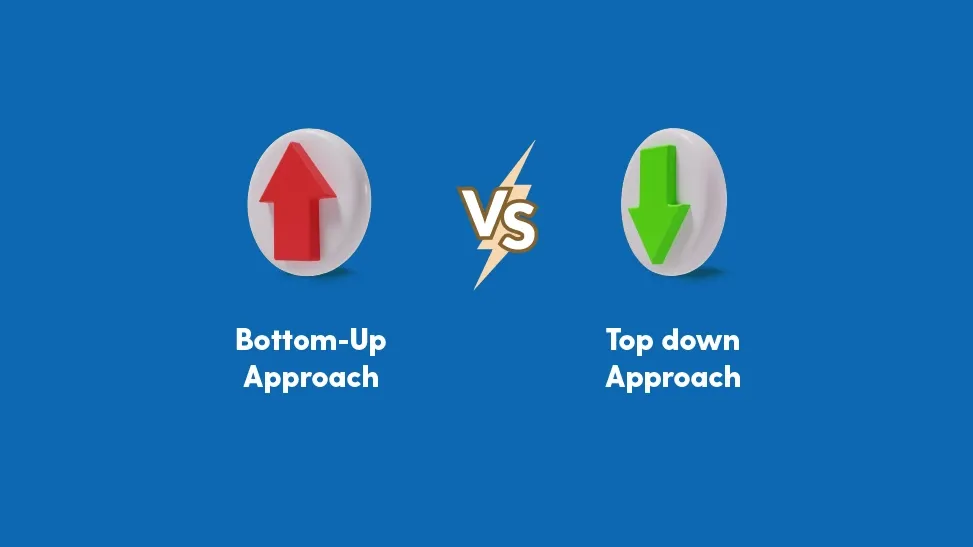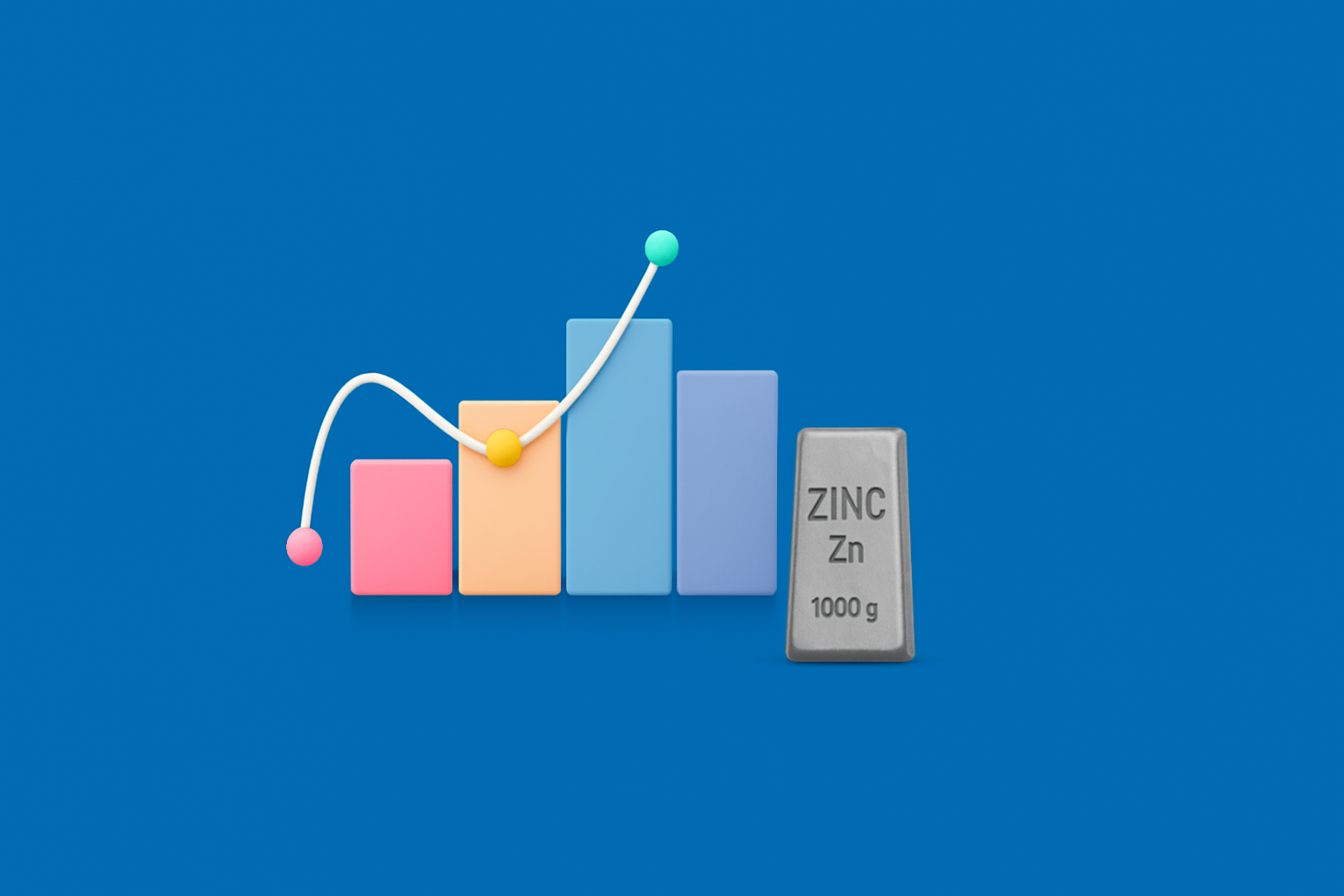- Home
- Blog
- Demat Account
- Bottom-Up VS Top-Down Approach: Your Guide To Investment Analysis
- Bottom-Up VS Top-Down Approach: Your Guide To Investment Analysis
Bottom-Up VS Top-Down Approach: Your Guide To Investment Analysis

- Published Date: November 02, 2024
- Updated Date: October 10, 2025
- By Team Choice
Investors use two primary methods to analyse investment opportunities: top-down and bottom-up approaches. The top-down approach begins with macroeconomic analysis before focusing on specific investments, while the bottom-up approach starts with individual companies regardless of broader market conditions.
This article explores both strategies, their applications in the Indian market, and how to effectively use them.
What is a Top-Down Approach?
A top-down approach starts with the big picture – analysing macroeconomic factors and gradually narrowing down to specific investments. Think of it like planning a trip to Switzerland: you first choose the country, then the state, the city, and finally, the specific places to visit.
How Top-Down Analysis Works
Macroeconomic Analysis
- Study GDP growth rates
- Monitor inflation rates and RBI policies
- Analyse global economic trends affecting Indian markets
- Assess political stability and policy changes
Sector Analysis
- Identify growing sectors in the economy
- Evaluate sector-specific policies and regulations
- Study competitive dynamics within industries
Example:
According to NASSCOM's 2023-24 Strategic Review, India's IT sector contributed 7.4% to the national GDP
Company Selection
- Choose leading companies within selected sectors
- Analyse market share and competitive position
- Evaluate financial health and growth prospects
What is a Bottom-Up Approach?
Company Fundamentals
- Financial ratios and metrics
- Management quality and corporate governance
- Competitive advantages
- Growth prospects
Business Model Analysis
- Revenue streams and pricing power
- Cost structure and efficiency
- Market positioning
- Innovation capabilities
Valuation
- Price-to-earnings (P/E) ratio
- Price-to-book (P/B) ratio
- Discounted cash flow analysis
- Comparative valuations
Difference Between Top-Down And Bottom-Up Approach
Here's a clear comparison of both approaches:
| Aspect | Top-Down Approach | Bottom-Up Approach |
|---|---|---|
| Starting Point | Macroeconomic factors | Individual companies |
| Focus | Broader market trends | Company fundamentals |
| Time Horizon | Generally shorter | Usually longer |
| Risk Assessment | Systematic risk focus | Company-specific risk focus |
| Best Suited For | Asset allocation decisions | Stock picking |
Real-World Application in Indian Markets
Top-Down Example
An investor notices India's push toward electric vehicles and government incentives in this sector. They:
- Analyse the automotive sector's growth potential
- Identify sub-sectors (like battery manufacturers)
- Finally select specific companies like Tata Motors or Mahindra Electric
Bottom-Up Example
An investor discovers Asian Paints has:
- Strong fundamentals
- Consistent revenue growth
- Excellent management
- Market leadership
They invest based on these company-specific factors, regardless of the broader economic conditions.
Combining Both Approaches
Many successful investors in India use a hybrid approach, combining elements of both strategies. Here's a practical framework:
Initial Screening
- Use top-down analysis to identify 2-3 promising sectors
- Screen for favorable policy and regulatory environment
- Assess sector growth rates and market potential
Company Selection
- Apply bottom-up analysis to identify 8-10 companies within chosen sectors
- Evaluate fundamental ratios (P/E, P/B, ROCE)
- Analyse competitive advantages and management quality
Final Analysis
- Cross-reference company performance with sector trends
- Validate growth assumptions against economic indicators
- Consider timing based on both macro and micro factors
Portfolio Integration
- Align selections with existing portfolio
- Consider position sizing based on conviction level
- Plan entry and exit strategies
Risk Management Framework
Understanding and managing risks is crucial for both approaches:
Top-Down Risks
- Economic cycle shifts
- Policy changes
- Sector rotation impacts
- Global market correlations
Bottom-Up Risks:
- Company-specific challenges
- Management changes
- Competition dynamics
- Financial leverage issues
Risk Mitigation Strategies:
- Diversification across sectors
- Position sizing based on risk assessment
- Regular portfolio rebalancing
- Stop-loss implementation
Tools and Resources for Analysis
Top-Down Analysis Tools:
- Economic indicators: RBI Bulletin, MOSPI data
- Sector reports: IBEF, industry associations
- Policy updates: Finance Ministry website
- Global market data: World Bank, IMF reports
Bottom-Up Analysis Tools:
- Financial statements: Company annual reports
- Stock screeners: NSE, BSE websites
- Industry analysis: CMIE, Value Research
- Corporate governance reports: SEBI filings
Performance Metrics Comparison
Top-Down Approach Performance Indicators:
- Sector performance vs. market indices
- Portfolio beta alignment with strategy
- Hit ratio on sector rotation decisions
- Risk-adjusted returns (Sharpe Ratio)
Bottom-Up Approach Performance Indicators:
- Stock-specific alpha generation
- Portfolio concentration metrics
- Company fundamental improvements
- Individual stock risk-adjusted returns
Which Approach Should You Choose?
- The choice between top-down and bottom-up approaches depends on multiple factors:
Investment Goals
- Short-term traders → Top-down often works better
- Long-term investors → Bottom-up might be more suitable
Available Resources
- Time for research
- Access to information
- Analytical capabilities
Market Knowledge
- Understanding of macroeconomics
- Company analysis skills
- Sector expertise
Benefits of a Combined Strategy
- More comprehensive analysis
- Better risk management
- Balanced perspective
- Improved decision-making
Key Takeaways
- The top-down approach suits investors who focus on economic trends and sector dynamics
- The bottom-up approach works well for those who excel at company analysis
- Both approaches have proven successful in the Indian market
- Consider combining both methods for a more robust investment strategy
Remember, successful investing isn't about choosing the "right" approach – it's about finding the method that best matches your investment style, knowledge, and resources.
Recommended for you

What Is Option Trading?

Zinc Future Price Forecast for Next Week

Copper Price Forecast for Next Week
